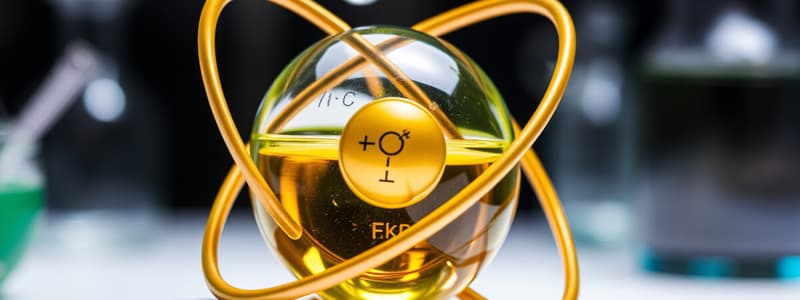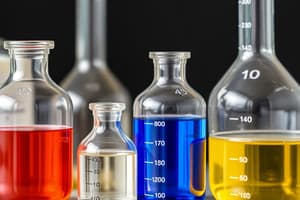Podcast
Questions and Answers
What is the current theory of the atom called?
What is the current theory of the atom called?
Atomic Theory
What is the difference between exothermic and endothermic reactions?
What is the difference between exothermic and endothermic reactions?
Endothermic takes in energy; exothermic gives off heat.
What part of an atom takes up the most space?
What part of an atom takes up the most space?
Electron cloud
What part of an atom has the most mass?
What part of an atom has the most mass?
Give an example of a compound.
Give an example of a compound.
What family of elements will never be ions?
What family of elements will never be ions?
A covalent bond is usually between _______________.
A covalent bond is usually between _______________.
An ionic bond is usually between _______________.
An ionic bond is usually between _______________.
What family is classified as Family 1?
What family is classified as Family 1?
What family is classified as Family 2?
What family is classified as Family 2?
Which families are classified as Families 3-12?
Which families are classified as Families 3-12?
What family is classified as Family 13?
What family is classified as Family 13?
What family is classified as Family 14?
What family is classified as Family 14?
What family is classified as Family 15?
What family is classified as Family 15?
What family is classified as Family 16?
What family is classified as Family 16?
What family is classified as Family 17?
What family is classified as Family 17?
What family is classified as Family 18?
What family is classified as Family 18?
Why is Hydrogen different from all other elements?
Why is Hydrogen different from all other elements?
Which element is along the zig-zag line but is not a metalloid?
Which element is along the zig-zag line but is not a metalloid?
Flashcards are hidden until you start studying
Study Notes
Atomic Theory
- Current theory of the atom is referred to as "Atomic Theory."
Endothermic vs. Exothermic Reactions
- Endothermic reactions absorb energy, such as ice melting.
- Exothermic reactions release heat, such as lighting a match.
Electron Cloud
- The electron cloud is the region of an atom that occupies the most space.
Nucleus
- The nucleus of an atom contains the majority of its mass.
Example of a Compound
- Carbon dioxide (CO2) serves as an example of a chemical compound.
Noble Gases
- Noble gases comprise a group of elements that do not form ions.
Covalent Bonds
- Covalent bonds typically form between two non-metals.
Ionic Bonds
- Ionic bonds generally occur between a metal and a non-metal.
Alkali Metals
- Alkali metals belong to Group 1 of the periodic table.
Alkaline Earth Metals
- Alkaline earth metals are found in Group 2.
Metals
- Metals are located in Groups 3 to 12 of the periodic table.
Boron Family
- Boron is classified under Group 13.
Carbon Family
- Carbon is part of Group 14 in the periodic table.
Nitrogen Family
- Nitrogen is categorized in Group 15.
Oxygen Family
- Oxygen belongs to Group 16.
Halogens
- Halogens are designated as Group 17 elements.
Noble Gases Revisited
- Noble gases occupy Group 18.
Unique Characteristic of Hydrogen
- Hydrogen is unique because it has no neutrons.
Aluminum's Classification
- Aluminum is positioned along the zig-zag line but is categorized as a metal, not a metalloid.
Studying That Suits You
Use AI to generate personalized quizzes and flashcards to suit your learning preferences.




